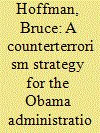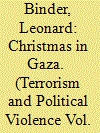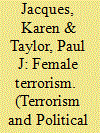|
|
|
Sort Order |
|
|
|
Items / Page
|
|
|
|
|
|
|
| Srl | Item |
| 1 |
ID:
089984


|
|
|
|
|
| Publication |
2009.
|
| Summary/Abstract |
This article assesses the scope and nature of the current terrorist threat to the United States and suggests a strategy to counter it. Al-Qaeda continues to pose the most serious terrorist threat to the U.S. today. If the September 11, 2001 attacks have taught us anything, it is that al-Qaeda is most dangerous when it has a sanctuary or safe haven from which to plan and plot attacks. Al-Qaeda has acquired such a sanctuary in Pakistan's Federal Administered Tribal Areas (FATA) and its North-West Frontier Province (NWFP) and surrounding environs. Accordingly, the highest priority for the new American presidential administration must be to refocus our-and our allies'-attention on Afghanistan and Pakistan, where al-Qaeda began to collapse after 2001, but has now re-grouped. This will entail understanding that al-Qaeda and its local militant jihadi allies cannot be defeated by military means alone. Success will require a dual strategy of systematically destroying and weakening enemy capabilities-that is, continuing to kill and capture al-Qaeda commanders and operatives-along with breaking the cycle of terrorist recruitment among radicalized "bunches of guys" as well as more effectively countering al-Qaeda's effective information operations. The U.S. thus requires a strategy that harnesses the overwhelming kinetic force of the American military as part of a comprehensive vision to transform other, non-kinetic instruments of national power in order to deal more effectively with irregular and unconventional threats. This article first discusses the scope and details of the terrorist threat today and then proposes a counterterrorism strategy for the new presidential administration. It focuses first on creating a micro approach to address the deteriorating situation in both Afghanistan and Pakistan. It then considers the requirements of a broader macro strategy to counter terrorism and insurgency.
|
|
|
|
|
|
|
|
|
|
|
|
|
|
|
|
| 2 |
ID:
089992


|
|
|
|
|
| Publication |
2009.
|
| Summary/Abstract |
The radical Hamas leadership in Damascus was remarkably successful in goading the moderate Israeli to approve a massive attack on the Gaza Strip, but it has been notably less successful in reestablishing the putative cease-fire that had obtained since June 2008.
|
|
|
|
|
|
|
|
|
|
|
|
|
|
|
|
| 3 |
ID:
089987


|
|
|
|
|
| Publication |
2009.
|
| Summary/Abstract |
What are the causes of electoral violence? And how does electoral violence influence conflict resolution and democracy? This article argues for a conceptualization of electoral violence as a specific sub-category of political violence, determined mainly by its timing and target. The enabling conditions and triggering factors can be identified in three main areas: 1) the nature of politics in conflict societies, 2) the nature of competitive elections, and 3) the incentives created by the electoral institutions. These clusters of factors are important for understanding electoral violence both between different societies and across elections in a specific country.
|
|
|
|
|
|
|
|
|
|
|
|
|
|
|
|
| 4 |
ID:
089986


|
|
|
|
|
| Publication |
2009.
|
| Summary/Abstract |
This article explores the anti-pirate discourse as a feature of the present war on terror and the more general connection between state and non-state violence. The anti-pirate discourse in ancient and early modern history is explored where piracy was one of the main threats coming from the private use of force. The anti-piracy reference is used in the present anti-terror discourse to open the way for a more militaristic approach to fighting terrorism centered around the concept of "enemy of humanity." Naming the enemy as someone outside the reach of reason and of conventional warfare brands the enemy as fanatically intent on destruction for destruction's sake and a state's intention to fight the "war" dirty as the only route to success.
|
|
|
|
|
|
|
|
|
|
|
|
|
|
|
|
| 5 |
ID:
089991


|
|
|
|
|
| Publication |
2009.
|
| Summary/Abstract |
The sharp growth in the number of publications examining female involvement in terrorism has produced a valuable but un-integrated body of knowledge spread across many disciplines. In this paper, we bring together 54 publications on female terrorism and use qualitative and quantitative analyses to examine the range of theoretical and methodological approaches in these papers. Using a content analysis, we identify six primary research foci: Portrayal in media, Feminism, Interviews with terrorists, Group roles, Motivation and recruitment, and Environmental enablers. Results revealed a reliance on secondary rather than primary data, narrative rather than statistical comparisons, and descriptions rather than explanations of events.
|
|
|
|
|
|
|
|
|
|
|
|
|
|
|
|
| 6 |
ID:
089988


|
|
|
|
|
| Publication |
2009.
|
| Summary/Abstract |
This paper describes the spatio-temporal trends in terrorist incidents in the United States, from 1970 through 2004. Utilizing the Global Terrorism Database (GTD) and ancillary data, we examine both the frequency of incidents and their characteristics: location, target type, attack type, weapon type, and perpetrator group. While the frequency of terrorist incidents has declined since the 1970s, there still is significant activity nationwide. Instead of urban-rural or West Coast-East Coast divisions, the pattern is a more complex mosaic based on group identity, target, and weapon type. We conclude that there is an explicit geography of terrorism, one that is quite decentralized and highly localized.
|
|
|
|
|
|
|
|
|
|
|
|
|
|
|
|
| 7 |
ID:
089985


|
|
|
|
|
| Publication |
2009.
|
| Summary/Abstract |
Internationally-directed nation building combines great rhetorical promise with very mixed practical outcomes. In spite of considerable optimism on the part of international actors, and in spite of often substantial desire for a functioning government among targeted populations, it has not clearly succeeded in building states or nations. The question is why? While many authors look to the weaknesses of international efforts for explanation, the answers may lie instead in the difficult process of transition itself. Although transforming political and social interactions is often necessary in post-conflict contexts, doing so can intensify vulnerabilities and uncertainties that prevent reforming governments from establishing legitimacy. That can in turn enable the fragmentation of political authority and become a sort of worst case scenario for nation building. International actors have shown no ability to counteract fragmentation and in some cases may unwittingly aid its entrenchment. One reason for this is that nation building strategies seldom take account of the hazards of transition, particularly the ways in which international preferences and domestic needs may clash. This article examines nation building within the context of political transition to assess how and when international efforts serve to unite or splinter state authority. It argues that the capacity to improve outcomes rests in better understanding the dynamics of transition, particularly the group vulnerabilities that reform exacerbates. Where nation building cannot counteract fragmentation it cannot succeed, but will serve rather to create contexts where political violence is both easier and more likely.
|
|
|
|
|
|
|
|
|
|
|
|
|
|
|
|
| 8 |
ID:
089989


|
|
|
|
|
| Publication |
2009.
|
| Summary/Abstract |
This study presents American state police agencies' perceptions about three significant terrorism and public safety issues. First, we asked about the threat posed by specified extremist groups nationally and to their state. We asked about the number of such groups and their supporters, and the number of activities each group participates in during a typical year in their state. We also asked about the number of criminal incidents each group commits and the number of their supporters arrested in a typical year. Second, we asked the agencies to rate the usefulness of fifteen specified terrorism sources. Third, we queried the agencies about their views of eight terrorism definitions. These data were collected by surveying the fifty state police agencies in the United States. We discovered widespread concern about the criminal activities of various extremist groups, with a particular concern about the threat of Islamic jihadists. Interestingly, although the top rated threat was Islamic jihadists, the respondents indicated that other types of groups were much more criminally active. Further, respondents indicated that various open and non-open sources were valuable terrorism sources. Finally, most respondents reacted more favorably to official terrorism definitions-especially the FBI's-as opposed to academic definitions. We conclude with a discussion of the policy implications of our findings and we outline directions for future research.
|
|
|
|
|
|
|
|
|
|
|
|
|
|
|
|
| 9 |
ID:
089990


|
|
|
|
|
| Publication |
2009.
|
| Summary/Abstract |
Using data from the University of Maryland's Global Terrorism Database II, this paper first provides information on the nature of terrorist incidents in India in the period 1998-2004: the Indian states that were worst affected by terrorist incidents and fatalities; the terrorist groups responsible for such incidents and their modus operandi. Next, the paper focuses on the issue of fatalities from terrorist incidents. It inquires into the extent to which the number of fatalities following an incident was influenced by the type of attack (bombings, armed assault, etc.) and the extent to which it was influenced by the type of terrorist group. By examining the number of fatalities resulting from terrorist attacks in India, the paper disentangles the influence on this number of attack type and attack group. Lastly, the paper applies Atkinson's concept of equality-adjusted income to terrorism to arrive at the concept of equality-adjusted deaths from terrorist incidents: in order to avoid spectacular incidents resulting in the loss of a large number of lives-as in New York on September 11, 2001 and in Mumbai 26-29 November 2008-"society" might be prepared to tolerate "low-grade" terrorism which resulted in a larger number of deaths in total but avoided a large number of deaths from a single iconic incident.
|
|
|
|
|
|
|
|
|
|
|
|
|
|
|
|
|
|
|
|
|